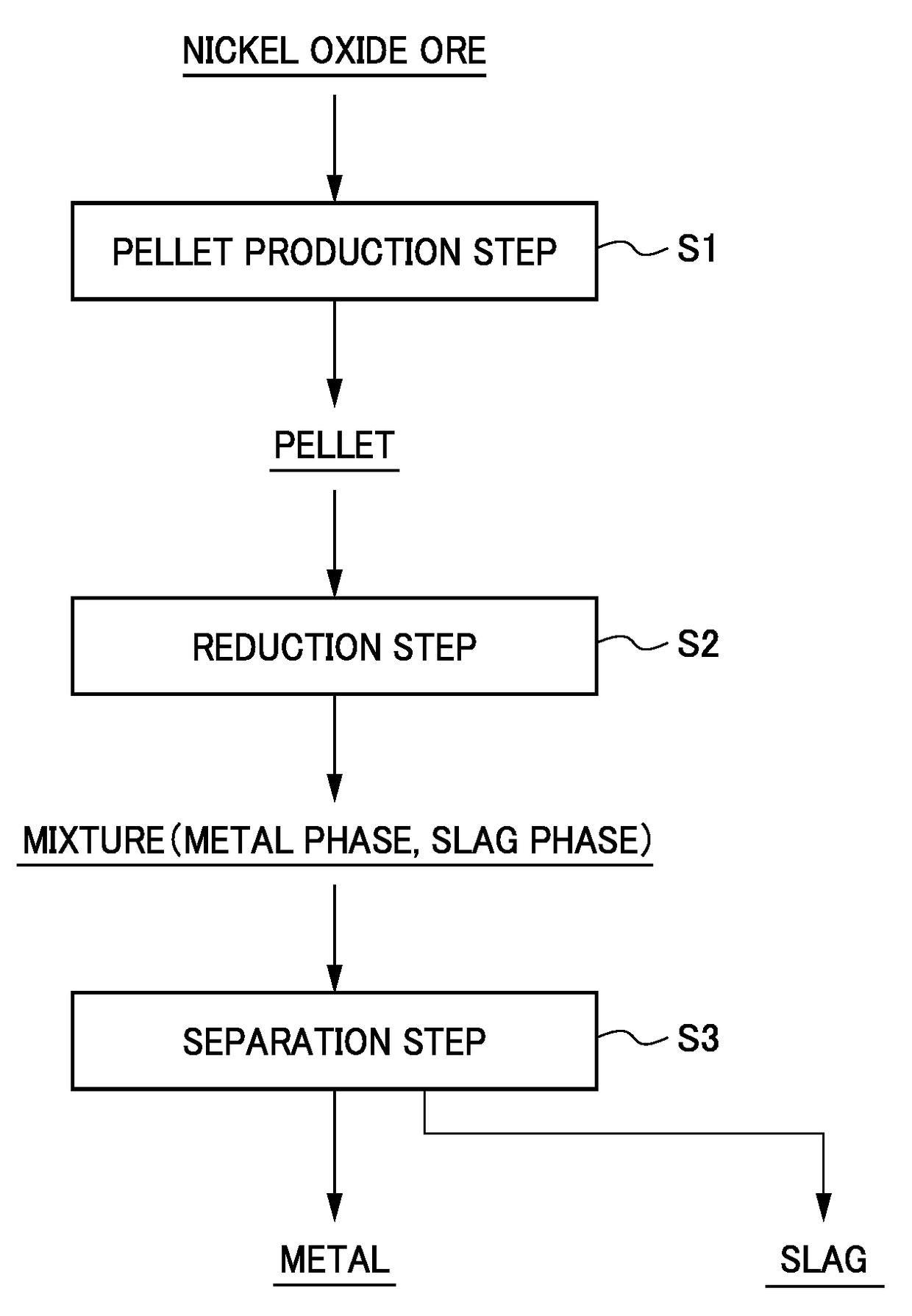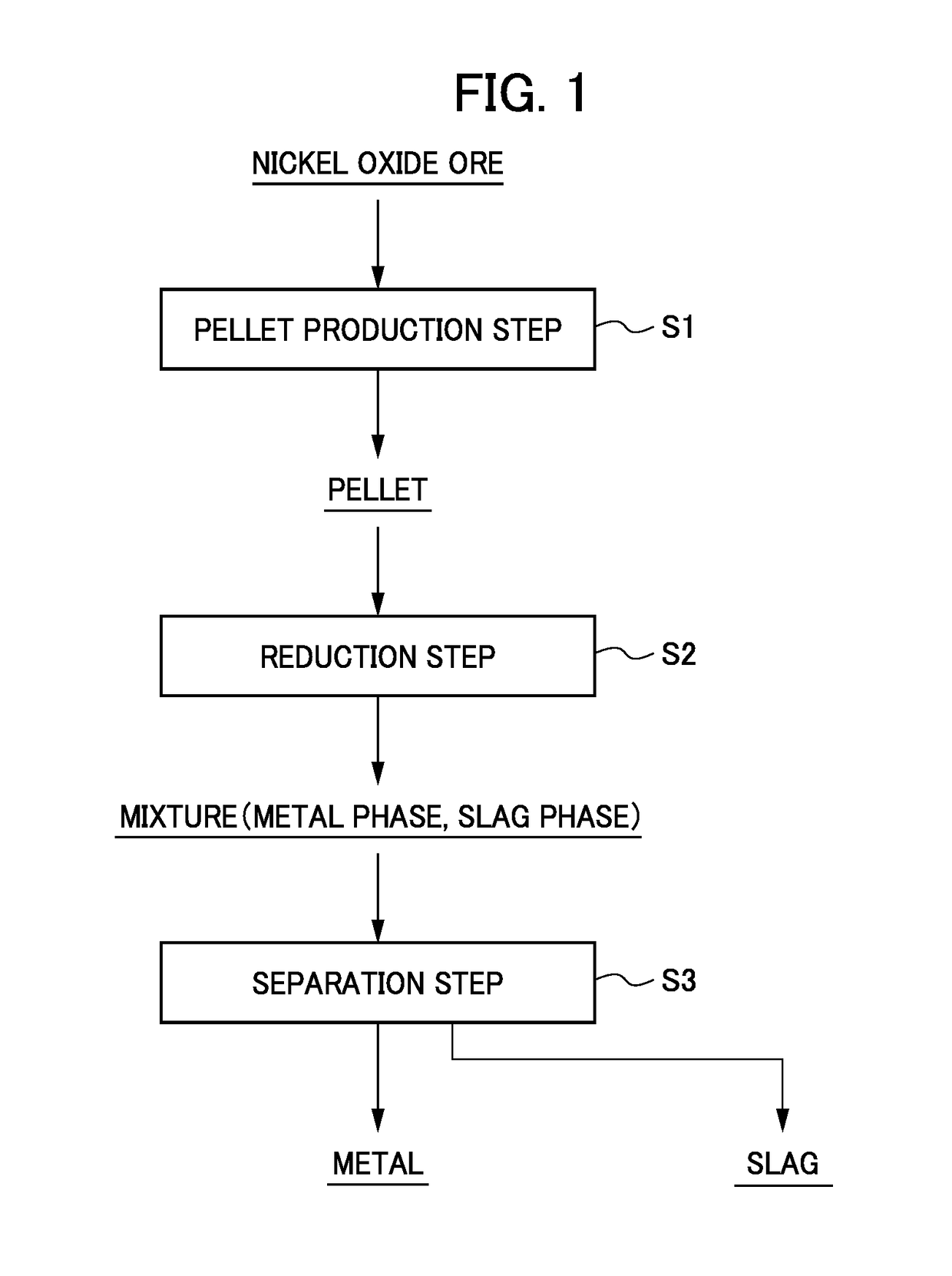Method for producing pellets and method for producing iron-nickel alloy
a technology of iron-nickel alloy and pellets, which is applied in the direction of fluidised-bed furnaces, furnace types, furnaces, etc., can solve the problems of time and labor, disadvantage in cost, and difficulty in handling, and achieve the effect of suppressing the ferronickel and allowing the smelting reaction to progress effectively
- Summary
- Abstract
- Description
- Claims
- Application Information
AI Technical Summary
Benefits of technology
Problems solved by technology
Method used
Image
Examples
example 1
[0060]While adding a predetermined amount of water, nickel oxide ore (limonite) as the raw material ore (A), carbonaceous reducing agent (B) and iron oxide (C) were mixed so as to make the ratios thereof A:B:C=6:3:5, flux component of limestone and silica sand was further mixed so as to be (CaO+MgO) / SiO2=0.6 to 2.5, thereby making a mixture of 50 wt % solid content and 50 wt % moisture. The component composition of nickel oxide ore, carbonaceous reducing agent and iron oxide (iron ore), which are the raw material powders used, is shown in Table 3 noted below.
[0061]
TABLE 3Particle size [mm]Raw material(Measurement bypowders [wt %]NiFe2O3Csieving method)Nickel oxide ore1.053—0.5Iron ore—85—0.7Carbonaceous——≈550.4reducing agent
[0062]Next, while adding water into the obtained mixture, it was kneaded by hand to form a spherical lump so that the pellet size when completed would be on the order of 10 mm to 30 mm. Then, this lump was dried so as to be 70 wt % solid content and 30 wt % moist...
example 2
[0068]Except for generating a mixture by mixing the raw material powders so as to make the ratios A:B:C=5.5:3:4.5, and producing pellets using this mixture, it was carried out similarly to Example 1. It should be noted that the size of the pellets obtained (diameter) was about 17 mm, and the total weight of nickel and iron in the pellet was 40 wt %.
[0069]As a result thereof, the number of ferronickel grains obtained was 10, and the Ni content in this ferronickel was 1.5 wt %.
[0070]In this way, it was possible to make the smelting reaction progress effectively in Example 2, and thus possible to suppress the ferronickel obtained after the smelting reaction from splitting into small grains.
example 3
[0071]Except for generating a mixture by mixing the raw material powders so as to make the ratios A:B:C=6:3:3, and producing pellets using this mixture, it was carried out similarly to Example 1. It should be noted that the size of the pellets obtained (diameter) was about 17 mm, and the total weight of nickel and iron in the pellet was 30 wt %.
[0072]As a result thereof, the number of ferronickel grains obtained was 10, and the Ni content in this ferronickel was 1.7 wt %.
[0073]In this way, it was possible to make the smelting reaction progress effectively in Example 3, and thus possible to suppress the ferronickel obtained after the smelting reaction from splitting into small grains.
PUM
| Property | Measurement | Unit |
|---|---|---|
| size | aaaaa | aaaaa |
| temperature | aaaaa | aaaaa |
| diameter | aaaaa | aaaaa |
Abstract
Description
Claims
Application Information
 Login to View More
Login to View More - R&D
- Intellectual Property
- Life Sciences
- Materials
- Tech Scout
- Unparalleled Data Quality
- Higher Quality Content
- 60% Fewer Hallucinations
Browse by: Latest US Patents, China's latest patents, Technical Efficacy Thesaurus, Application Domain, Technology Topic, Popular Technical Reports.
© 2025 PatSnap. All rights reserved.Legal|Privacy policy|Modern Slavery Act Transparency Statement|Sitemap|About US| Contact US: help@patsnap.com



